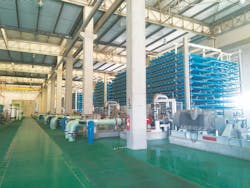Advanced Filtration Technologies for Alternative Water Sources
About the author:
Milena Yordanova is marcom manager for DuPont Water Solutions. Yordanova can be reached at [email protected].
Sea- and brackish water desalination has, until recent years, been cost prohibitive for more widespread human, industrial and agricultural use. However, as technology advances and scarcity in both developing and developed countries increases, it has become an increasingly viable water source as human needs by 2050 grow by 30% and industry requires 400% more water. At the heart of this shift are membranes that filter the salty water by osmosis rather than by using energy-intensive thermal processes to create and collect condensate.
A Symbiotic Combination of Technologies
Combining reverse osmosis (RO) with ultrafiltration (UF) for pretreatment is a proven method, with numerous examples of an integrated solution from DuPont now in operation.
Conventional filtration methods, such as sand filters and media filtration, require a consistent raw water quality to deliver quality effluent, which is not always possible. They also do not provide an absolute barrier. Traditional media filters typically remove particles to down to about 5 microns. UF, however, does not suffer from those limitations. This technology uses an ultrafiltration membrane barrier to exclude particles as small as 0.02 to 0.05 microns, including bacteria, viruses and colloids, helping with the RO to meet increasingly stringent water-quality standards around the world, and providing a stable, reliable and consistent water quality.
An Advanced Desalination Plant
DuPont was part of a project that won the Global Water Intelligence award for technical and ecologically sustainable achievement in 2019 for the Tuas desalination plant in Singapore. Here, the UF system pre-treats water to prevent membrane fouling in order to double the lifespan of the RO membranes. Tuas has become one of Asia’s biggest seawater RO desalination plants for drinking water production and demonstrates the capability of an UF and RO combination. The success led to a follow-up contract to replace spent membranes from another manufacturer at Tuas South for both the UF and RO elements. This plant has a capacity of 200 mgd with an RO capacity of 84 mgd with a highly reliable and predictable operation. The customer was particularly interested in lowering the total cost of produced water. After an intensive nine month pre-bid consultation, they chose the combined UF and RO solution.
Stamina & Durability All Around the World
Being able to operate a desalination plant for longer without interruption has significant advantages, including decreased plant downtime; reduced cost of maintenance staff; and lower membrane replacement costs. The durability of DuPont membranes can lower the total cost of ownership by 22% over five years due to the lower replacement cost.
Further benefits of using the durability of the membranes include less disruption to operations and a greater system predictability, less health and safety risk, and a smaller environmental footprint by reducing the number of spent elements going for disposal.
In Spain alone, for example, there are four cases that exemplify uninterrupted operation in particular: in Torrevieja and Águilas they have been operating without replacement for more than seven years. In Alicante, it is more than 12 years. At the San Pedro del Pinatar desalination plant, almost 6,500 elements have passed 14 years of uninterrupted service. Furthermore, at the Khor Fakkan plant in Sharjah, membranes play a vital role for the water supply of the UAE, having proven their durability in consistent operation since 2008. Lastly, Perth in Australia holds the country’s first large-scale desalination plant, a response to extreme drought, growing population and increasingly unpredictable rainfall. The membranes there have reliably done their duty for more than 14 years.
More Efficiency, Less Energy
An additional focus of DuPont’s desalination R&D is on reducing energy consumption. Thanks to technological advancement, over the last 20 years the amount of energy required for water production has been reduced by 80%. This is one of the main reasons why desalination now costs only half of what it did a decade ago. According to the International Water Association (IWA), it now consumes less energy to provide a family with fresh desalinated water than they use for their fridge.
Novel ways have been found to further increase energy efficiency. Biofouling resistant membrane elements, for example, offer a 34% lower pressure drop than even the high-performing predecessors. The membrane chemistry offers a stable permeate conductivity over multiple cleanings. This results in a reduction of more than 33% in the number of chemical cleanings caused by biofouling, and therefore, higher uptime, improved plant reliability and less energy use. In a desalination plant large enough for 400,000 people, the use of such biofouling resistant membranes can reduce water production costs by up to 5.5% in the RO stage and generate a total saving of 0.0134 US$/m3 in the whole desalination plant. This equals approximately US $490,000 of yearly savings. Combining this with other techniques, such as Internally Staged Design (ISD) approaches, promises further energy savings and an even better fouling resistance performance.
Desalinated Water – From a Luxury to a Staple Good
As the physical limits of individual technologies like membranes have been reached, the focus has been to make desalination less energy and chemical intensive, cleaner and cheaper to operate — making gains in the overall application of membrane systems. Longer lifespans with fewer interruptions and replacements, less biofouling, optimized system designs and the combination of complementary technologies all contribute to more efficient operation. As such, desalination has become less complex and certainly less costly. It still takes experts to operate it at a large scale, as with any piece of essential infrastructure, but the total cost of ownership of doing so has been reduced to a level that makes desalination a favorable economic and ecological choice in developed and developing economies alike.
